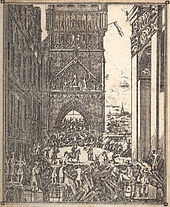Franz Schneider von Dillenburg
Franz Schneider von Dillenburg (* May 8, 1799 , † February 6, 1879 in Teplitz ) was an Austrian kk major general and member of the kk Elisabeth-Theresien -military foundation.
origin
Franz was the son of the Imperial and Royal Captain Heinrich Schneider, who by the highest resolution of Emperor Franz I of February 15, 1821 and diploma of May 4 of the same year in Vienna in consideration of his 30 years of service and proven bravery, including his legitimate offspring of both sexes the predicate "von Dillenburg" was raised to the hereditary-Austrian nobility.
biography
The lieutenant in the Hochenegg Infantry Regiment No. 20 was promoted to first lieutenant in his regiment in 1830, lieutenant captain in 1833 and a year later a real captain .
Schneider fought as commander of the 3rd battalion in the army corps of Field Marshal Lieutenant Balthasar von Simunich from June 12th to 17th, 1848 in the defeat of the Whitsun uprising in Prague in street fighting and the storming of the barricades, and on July 19th of that year he became major and commander of the new established 4th field battalion. Then he took part during the Hungarian uprising on December 16 of that year in the storming and capture of Tyrnau and in the enclosure of the small fortress Leopoldstadt . In early February 1849, he became the Zernierung of Komarno used. For his courage, in addition to the rank tour, he was appointed lieutenant colonel and first battalion commander on May 1, 1849 , and on February 17, 1850, in a public ceremony in Komotau , he was awarded the Military Merit Cross for his excellent services in Hungary - especially in the battle of Iháza .
On October 20, 1853 , Emperor Franz Joseph I transferred the title of owner of the 20th regiment, which had become vacant due to the death of the regiment owner , to Prince Friedrich Wilhelm of Prussia with the simultaneous appointment of Schneider von Dillenburg as colonel and regimental commander.
On July 25, 1857, the member of the kk Elisabeth-Theresien -military foundation was retired, also bearer of the service and cannon cross with the title and character of major general. After adding the so-called war decoration to the Military Merit Cross, he too was granted this honor.
The officer remained single and died of Marasmus at the age of 80 in his retirement home in Teplitz .
coat of arms
1821: Under the blue head of the shield, three silver stars side by side in the same, split by a silver point of red that reaches up to the top. In front on the green ground a fortress tower with two windows and a tinned wall, in this side by side five loopholes. Behind on the green ground a resting golden lion, between the front paws a flag in a pole, in the golden flag field a black double-headed eagle and at the top on a green hill a green leafy tree, on the trunk a lance and a saber lying at an angle. On the crown of the helmet an armored arm in hand holding a sword. The blankets are blue-silver and red-gold.
Individual evidence
- ^ Ernst Heinrich Kneschke: New general German Adels Lexicon. Volume 8, Verlag Friedrich Voigt's Buchhandlung, Leipzig 1868, p. 266.
- ↑ Austrian observer. No. 125 of May 5, 1821, p. 591.
- ↑ Joh. Baptist Schels (Red.): Austrian military magazine. Volume 3, Issue 9, printed by Anton Strauss's blessed widow, Vienna 1830, p. 337.
- ↑ Joh. Baptist Schels (Red.): Austrian military magazine. 1st volume, 1st issue, printed by Anton Strauss's blessed widow, Vienna 1833, p. 89.
- ↑ Joh. Baptist Schels (Red.): Austrian military magazine. 2nd volume, 4th issue, printed by Anton Strauss's blessed widow, Vienna 1834, p. 105.
- ^ Wiener Zeitung. No. 221 of August 12, 1848, p. 1.
- ↑ Gustav Ritter Ammon von Treuenfest: History of the Imperial and Royal Infantry Regiment No. 20 Friedrich Wilhelm, Crown Prince of the German Empire. Verlag des Regiment, printed by Ludwig Mayer, Vienna 1878, p. 508.
- ^ Andreas Graf Thürheim: Commemorative sheets from the war history of the Austro-Hungarian army. Volume 1, Verlag der Buchhandlung für Militär-Literatur K. Prochaska, Vienna and Teschen 1880, pp. 127, 129.
- ↑ Klagenfurter Zeitung. No. 59 of May 17, 1849, p. 1.
- ↑ Austrian soldier friend . No. 25 of February 26, 1850, p. 113.
- ^ Ernst Heinrich Kneschke: New general German Adels Lexicon. Volume 1, Verlag Degener & Co., Leipzig 1929, p. 266.
- ↑ Gustav Ritter Ammon von Treuenfest: History of the Imperial and Royal Infantry Regiment No. 20 Friedrich Wilhelm, Crown Prince of the German Empire and Crown Prince of Prussia. Verlag des Regiment, 1878, p. 639.
- ↑ Teplitz-Schönauer Anzeiger. No. 6 of February 8, 1879, p. 4.
- ^ Antonio Schmidt-Brentano: The kk or kuk generality 1816-1918. Austrian State Archives, Vienna 2007, p. 165.
- ^ Military schematism of the Austrian Empire for 1861-1862. KK Hof- und Staatsdruckerei, Vienna 1862, p. 117.
- ↑ Prager Tagblatt. No. 39 of February 8, 1879, p. 3.
- ^ Rudolf J. Count of Meraviglia-Crivelli: The Bohemian nobility. in: Siebmacher's coat of arms books. Volume IV, 9th section, Nuremberg 1886, p. 27, T. 23.
| personal data | |
|---|---|
| SURNAME | Tailor from Dillenburg, Franz |
| BRIEF DESCRIPTION | Austrian major general |
| DATE OF BIRTH | May 8, 1799 |
| DATE OF DEATH | February 6, 1879 |
| Place of death | Teplitz |


